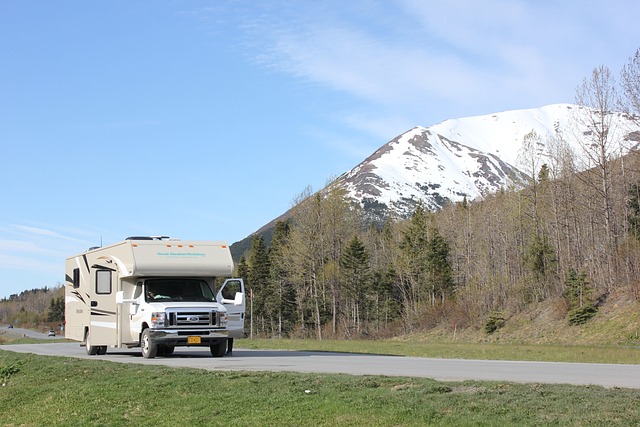Embarking on an RVing for Beginners journey requires careful planning and understanding of your vehicle's dimensions to navigate confidently. Effective route planning involves considering road types, elevation profiles, weather forecasts, and campground options, and utilizing GPS systems tailored for RVs to avoid low clearance areas and potential hazards. Novice RVers should also strategically plan for rest areas, service stations, and dump stations along their route for convenience and maintenance. Proactive campsite reservations are crucial for stress-free lodging each night. Integrating traditional paper maps with RV-specific GPS, onboard diagnostic tools, and smartphone apps that provide real-time traffic and weather updates, as well as information on points of interest, will enhance your travel experience. Safety and convenience can be further improved with dash cams or backup cameras during maneuvers. By preparing the campsite properly, managing storage efficiently, embracing the slower pace of RV life, and pacing yourself, you'll find that RVing for Beginners is an enriching and stress-free adventure, filled with exploration and satisfaction.
Embarking on an RV journey can be a thrilling adventure, offering a unique blend of comfort and exploration. For those new to RVing, mastering route planning and navigation is key to a stress-free trip. This article guides beginners through the essential steps of crafting a seamless journey, highlighting vital tools and technologies that simplify navigation in an RV. With practical strategies for both driving and camping, you’ll be well-equipped to enjoy the open road, ensuring your RVing experience is as smooth as the landscapes you traverse.
- Mastering the Art of RV Route Planning: Essential Steps for Beginners
- Essential Tools and Technologies for Hassle-Free Navigation in an RV
- Strategies for Stress-Free Driving and Camping Experiences While RVing
Mastering the Art of RV Route Planning: Essential Steps for Beginners

Embarking on an RV trip can be a delightful escape from the daily grind, offering a blend of adventure and comfort. For beginners to RVing, mastering route planning is crucial for ensuring a smooth journey. Effective route planning for an RV involves more than just choosing the shortest path between two points; it requires consideration of road types, elevation changes, weather patterns, and campground availability. Beginners should start by familiarizing themselves with the dimensions of their RV to navigate through areas with low clearance or tight turns. Utilize GPS systems designed for RVs, which take into account the vehicle’s size and provide routes that are safe and suitable for such a rig.
When planning your route, it’s important to consider road conditions, including weight limits and road type. For instance, certain roads may be designated for trucks only, or have height restrictions that could pose challenges for RV travel. Additionally, always account for the location of rest areas, service stations, and certified dump stations along your route. Planning for necessary stops not only ensures convenience but also allows for regular vehicle checks to prevent unexpected issues on the road. Furthermore, reserving campsites ahead of time can save frustration and ensure that you have a comfortable place to rest each night. By taking these steps, novice RVers can navigate their journey with greater confidence, turning their RV adventure into a memorable experience filled with discovery and joy.
Essential Tools and Technologies for Hassle-Free Navigation in an RV

Embarking on an RV trip can be a delightful experience, offering the freedom to explore new destinations at your own pace. For beginners in RVing, mastering the art of navigation and route planning is crucial for a stress-free journey. To facilitate this, a combination of essential tools and advanced technologies plays a pivotal role. Firstly, traditional paper maps should be a staple in every RV, providing a reliable backup in case of electronic failures. GPS systems tailored for RVs are highly recommended, as they offer routes that avoid low clearance bridges and narrow roads not suitable for larger vehicles. These GPS units can also locate RV parks and campgrounds, which are essential for planning your overnights.
In addition to GPS, onboard diagnostic tools can monitor the RV’s engine performance and inform drivers of potential issues before they escalate into serious problems. Smartphone apps that specialize in RV travel can enhance the experience by providing real-time traffic updates, weather conditions, and even locating points of interest along your route, such as rest areas, attractions, and service stations. For those who enjoy the digital realm, a dash cam or backup camera system can offer added safety and peace of mind while maneuvering in tight spaces or navigating unfamiliar areas. By leveraging these tools and technologies, RVing for beginners can navigate with confidence, ensuring their journey is as enjoyable as it is memorable.
Strategies for Stress-Free Driving and Camping Experiences While RVing

When embarking on RVing adventures, particularly for beginners, mastering stress-free driving and camping experiences is key to ensuring a memorable and enjoyable trip. To start with, drivers should familiarize themselves with the RV’s dimensions and limitations, as navigating such a large vehicle requires more space for turns and maneuvers. Practice in an open area can build confidence and reduce anxiety. It’s also wise to plan routes ahead of time using RV-specific GPS systems or applications that identify truck-friendly roads, avoiding low clearance bridges and tight quarters. These tools can also suggest rest areas and overnight stops, which are critical for maintaining a relaxed pace throughout the journey.
Once you’ve arrived at your destination, stress-free camping hinges on advance preparation. Beginners should select campsites that cater to RVers, often marked with symbols on maps or in online listings. Arriving early allows for optimal site selection and time to set up without rushing. Organize the RV’s storage compartments thoughtfully, so you can quickly access necessary gear or supplies without creating a disarray that can be overwhelming. Additionally, having a routine for connecting services like water, electricity, and sewage will streamline your camp setup process. Remember to pace yourself and embrace the slower rhythm of RV life; this mindset shift can significantly contribute to a stress-free RVing experience for beginners.
Navigating the open road in an RV can be a delightful escape from the hustle and bustle of everyday life. With the right route planning and technological tools, even RVing for beginners can embark on stress-free adventures. This article has outlined key strategies to ensure your journey is smooth sailing, from selecting the ideal route to utilizing advanced navigation systems. By following the steps in ‘Mastering the Art of RV Route Planning’ and equipping yourself with the technologies highlighted in ‘Essential Tools and Technologies for Hassle-Free Navigation in an RV,’ you’re well-prepared for a memorable RV experience. Remember to implement the strategies for stress-free driving and camping outlined in ‘Strategies for Stress-Free Driving and Camping Experiences While RVing.’ With these insights, the wonders of the road are yours to discover, making RVing for beginners an accessible and enjoyable pursuit. Happy travels!
